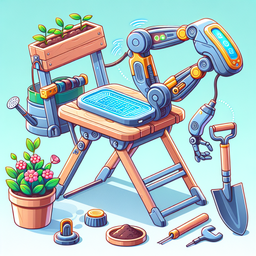I. Introduction to Gardening Notebooks
Gardening notebooks are essential tools for gardeners to keep track of their plants, garden designs, seasonal planning, and pest management. These notebooks serve as personalized journals for recording crucial information about the garden's growth and development.
A. Definition and Purpose
A gardening notebook is a journal where gardeners can record details such as plant profiles, garden layouts, maintenance schedules, and pest control methods. It acts as a comprehensive guide to the garden, providing a valuable resource for future reference and planning.
B. Importance of Keeping a Gardening Notebook
According to renowned horticulturist Margaret Roach, 'A gardening notebook is a gardener's best friend. It helps you track successes and failures, plan for the future, and learn from your gardening experiences.' Keeping a gardening notebook can significantly enhance a gardener's ability to monitor and improve their garden.
C. Testimonials from Expert Gardeners
Expert gardener Sarah Raven emphasizes the significance of gardening notebooks: 'I rely on my gardening notebook to remember what worked well in previous seasons, which plants need special care, and how to improve the garden's overall performance.' Many experienced gardeners praise the value of maintaining detailed gardening records.
II. Components of a Gardening Notebook
A well-organized gardening notebook consists of several key components that are essential for efficient garden management and documentation.
A. Plant Profiles and Records
Incorporating detailed plant profiles, including plant names, varieties, planting dates, growth progress, and maintenance requirements, allows gardeners to track each plant's performance and make informed decisions for future care.
B. Garden Layout and Design
Sketching garden layouts, noting plant placements, paths, structures, and design elements helps visualize the garden's overall look and facilitates planning for seasonal changes and expansions.
C. Seasonal Planning and Maintenance
Recording seasonal tasks, such as planting schedules, pruning routines, fertilization practices, and pest control measures, ensures timely and appropriate care for plants throughout the year.
D. Pest and Disease Management
Documenting pest and disease issues, along with solutions implemented and their efficacy, assists in identifying recurring problems and developing effective strategies for preventing and managing garden pests.
III. How to Create and Organize Your Gardening Notebook
Creating and organizing a gardening notebook involves selecting the right notebook, establishing sections and categories, adopting recording tools and techniques, and implementing effective organization methods.
A. Choosing the Right Notebook
Gardening author and blogger Monty Don advises, 'Choose a notebook that is durable, weather-resistant, and easy to carry around the garden. Consider size, paper quality, and binding when selecting a notebook for your gardening needs.'
B. Setting Up Sections and Categories
Dividing the notebook into sections for different aspects of gardening, such as plant profiles, garden layouts, maintenance schedules, and pest records, helps maintain order and facilitates quick access to specific information.
C. Tools and Techniques for Recording Information
Utilizing tools like waterproof pens, color-coded tabs, sticky notes, and plant labels, and techniques such as sketching, charting, and note-taking enhances the efficiency and usability of the gardening notebook.
D. Tips for Effective Organization
Organizing the notebook chronologically, indexing key entries, using clear labeling and annotations, and regularly updating information ensure that the gardening notebook remains up-to-date, informative, and easy to navigate.
IV. Case Studies: Real-Life Examples of Gardening Notebooks
Examining real-life examples of gardening notebooks provides insights into how different gardeners utilize these tools for various types of gardens and gardening practices.
A. Urban Gardener's Notebook: Balcony Container Garden
Urban gardener Lisa showcases her balcony container garden notebook, featuring compact plant profiles, space-efficient designs, and creative solutions for maximizing limited gardening space.
B. Vegetable Gardener's Notebook: Crop Rotation and Succession Planting
Vegetable enthusiast Mark shares his notebook focused on crop rotation and succession planting, documenting planting schedules, harvest yields, and soil management strategies to optimize vegetable production.
C. Flower Enthusiast's Notebook: Perennial Garden Planning
Flower lover Emily showcases her notebook dedicated to perennial garden planning, highlighting plant combinations, bloom times, color schemes, and maintenance tips for a vibrant and cohesive garden display.
V. Benefits and Insights from Maintaining a Gardening Notebook
Maintaining a gardening notebook offers numerous benefits that can enhance a gardener's experience and elevate the productivity and aesthetics of their garden.
A. Tracking Plant Growth and Performance
'The ability to track plant growth, flowering patterns, and yield results over time enables gardeners to assess plant health, experiment with new techniques, and make informed decisions for future plantings,' states landscape designer Piet Oudolf.
B. Improving Garden Productivity and Efficiency
By analyzing past records, identifying successful practices, and avoiding previous mistakes, gardeners can optimize their garden's productivity, save time and resources, and achieve better results with each growing season.
C. Enhancing Garden Design and Aesthetics
Garden designer Jinny Blom emphasizes the role of gardening notebooks in design enhancement: 'Recording design ideas, plant combinations, and layout sketches allows for continuous improvement, creativity, and personal expression in the garden.'
D. Expert Insights on the Value of Garden Documentation
Award-winning landscaper Dan Pearson advocates for garden documentation: 'A gardening notebook captures the essence of a garden's journey, preserving memories, lessons learned, and the evolution of the landscape. It serves as a legacy for future generations of gardeners.'
VI. Conclusion
In conclusion, gardening notebooks serve as indispensable tools for gardeners of all levels, providing a systematic approach to garden management, documentation, and improvement. By embracing the concept of gardening notebooks, gardeners can unlock the full potential of their gardens and cultivate a deeper connection with their outdoor spaces.
A. Summary of Key Takeaways
- Gardening notebooks are personalized journals for recording plant details, garden designs, maintenance schedules, and pest management strategies.
- Organizing a gardening notebook involves selecting the right format, setting up sections, using appropriate tools, and maintaining effective organization.
- Real-life case studies demonstrate the diverse applications and benefits of gardening notebooks in different gardening contexts.
- Benefits of maintaining a gardening notebook include tracking plant performance, enhancing garden productivity, improving design aesthetics, and preserving gardening experiences.
B. Encouragement to Start Your Gardening Notebook Journey
Embark on your gardening notebook journey today and experience the transformative power of documenting your garden's growth, challenges, and triumphs. Share your progress, seek inspiration from fellow gardeners, and continue learning and evolving as a garden enthusiast.
VII. Call to Action
- Share Your Gardening Notebook Experiences: Join the conversation by sharing your gardening notebook tips, successes, and learnings with the gardening community.
- Explore Advanced Techniques in Gardening Documentation: Dive deeper into the world of gardening documentation by exploring advanced methods, tools, and strategies for maintaining detailed garden records.
- Connect with the Gardening Community for Further Learning and Inspiration: Engage with like-minded gardeners, participate in gardening forums, workshops, and events, and foster a supportive network of gardening enthusiasts for continuous growth and enrichment in your gardening journey.
Topics




